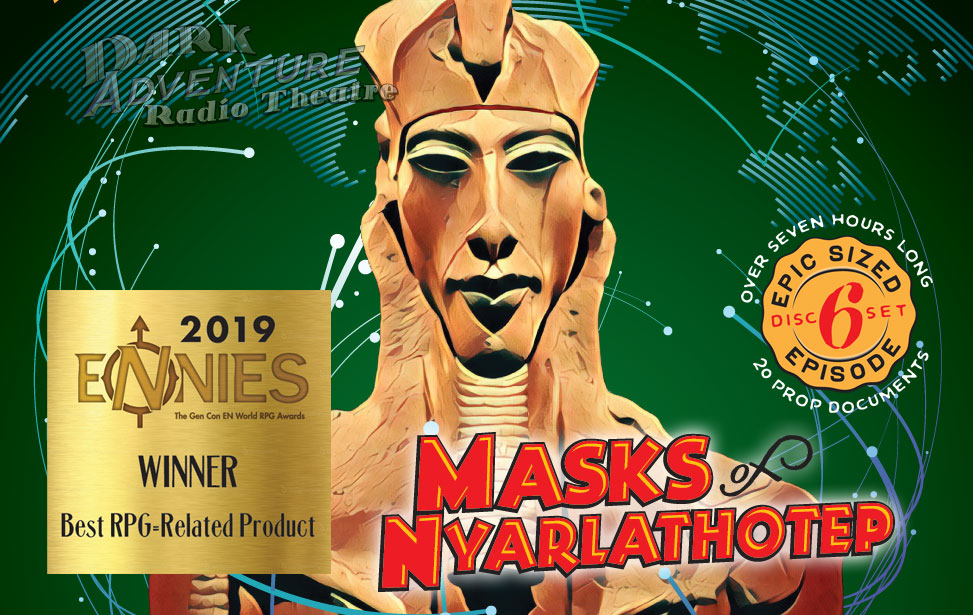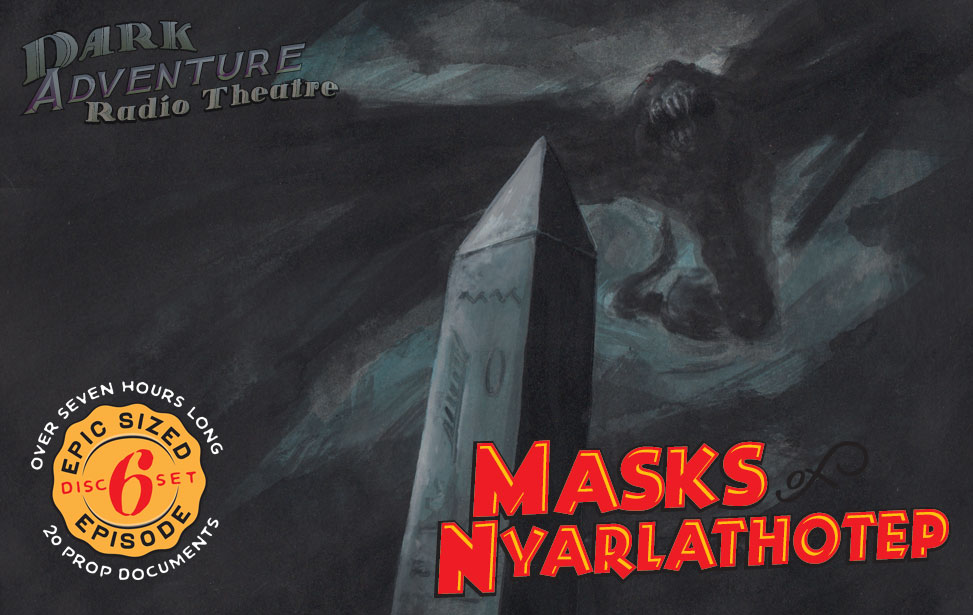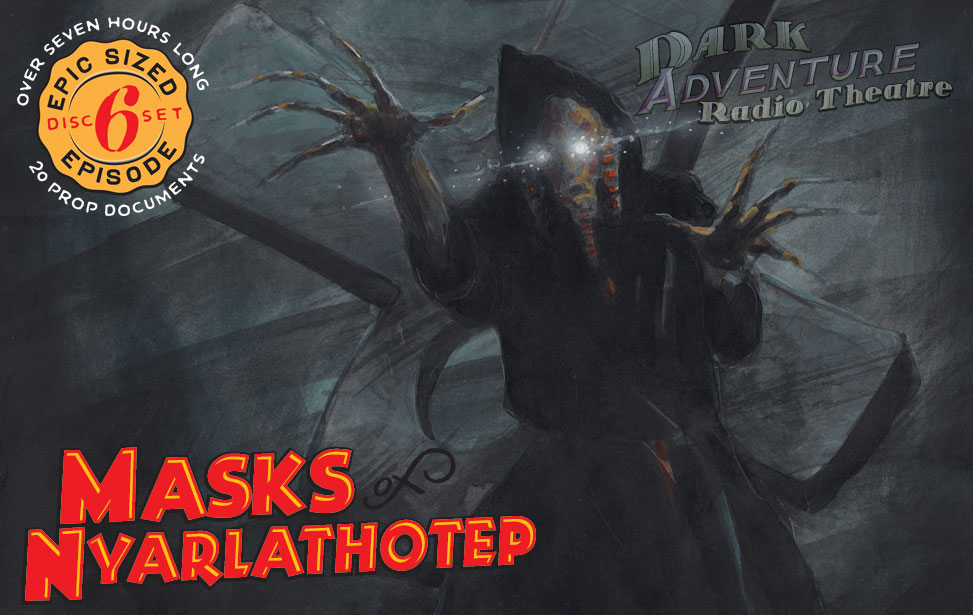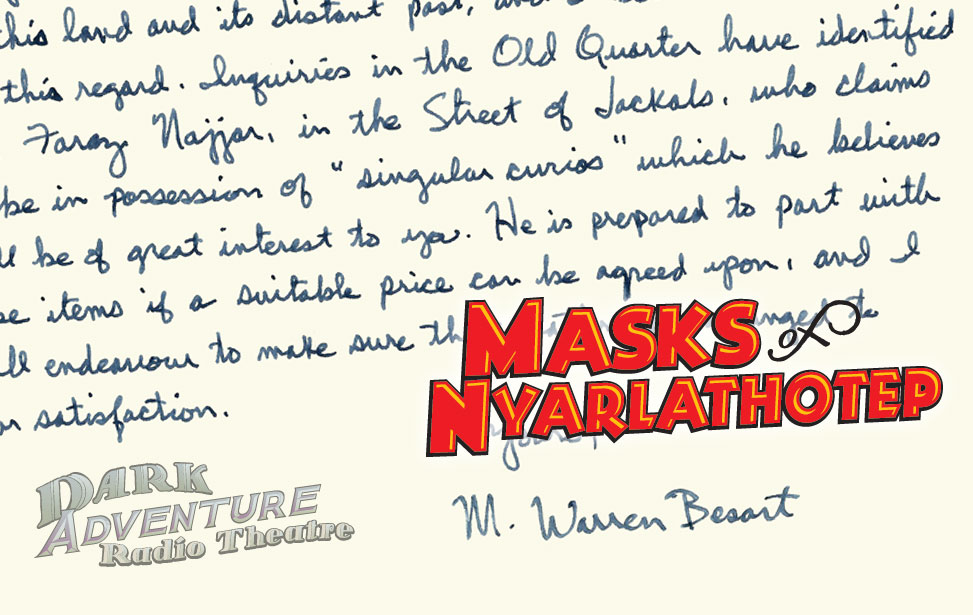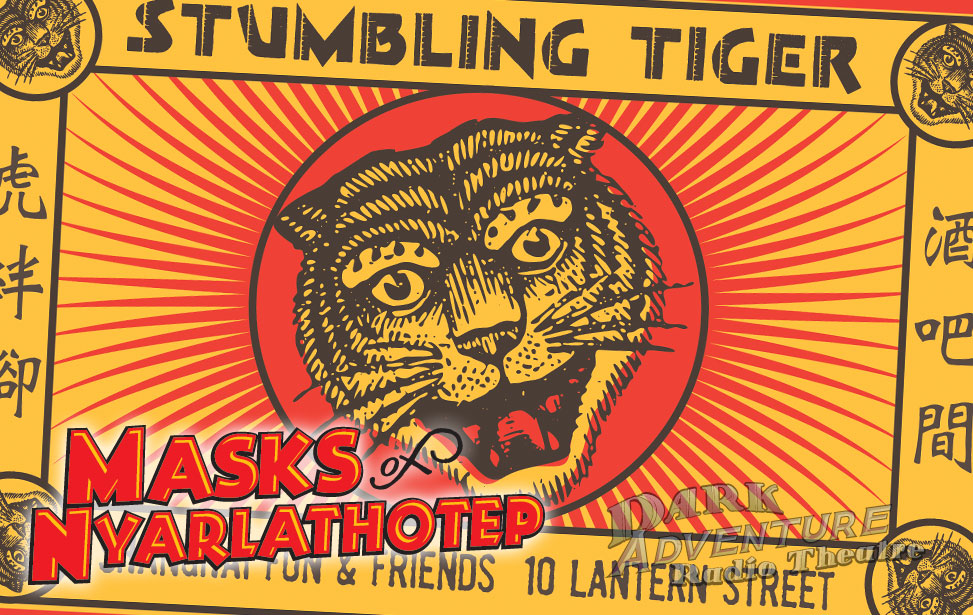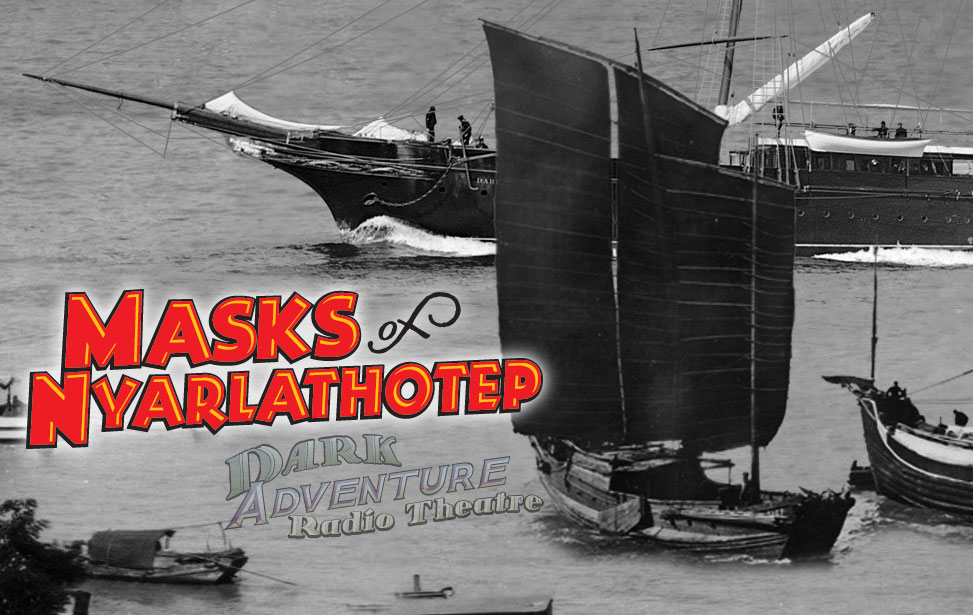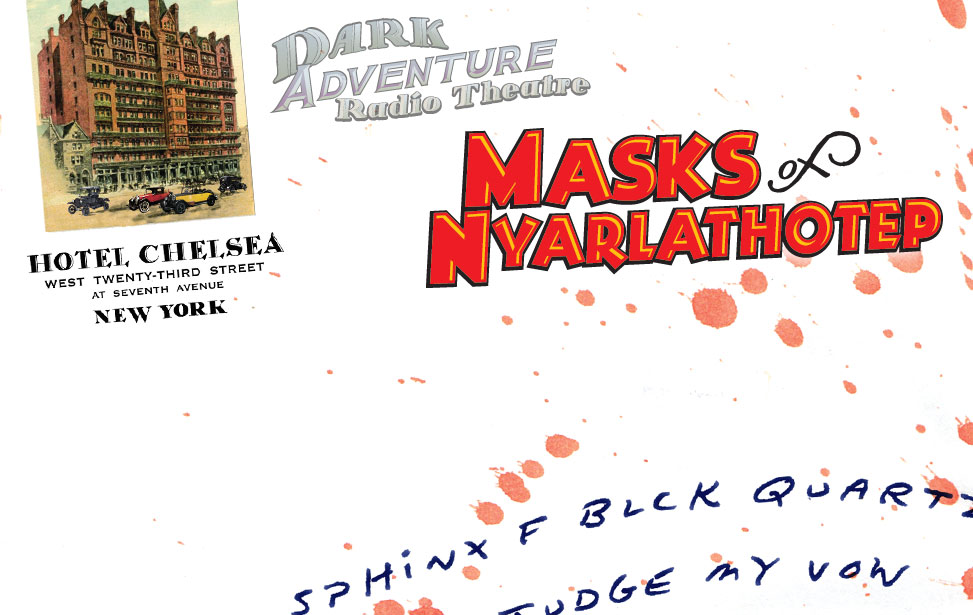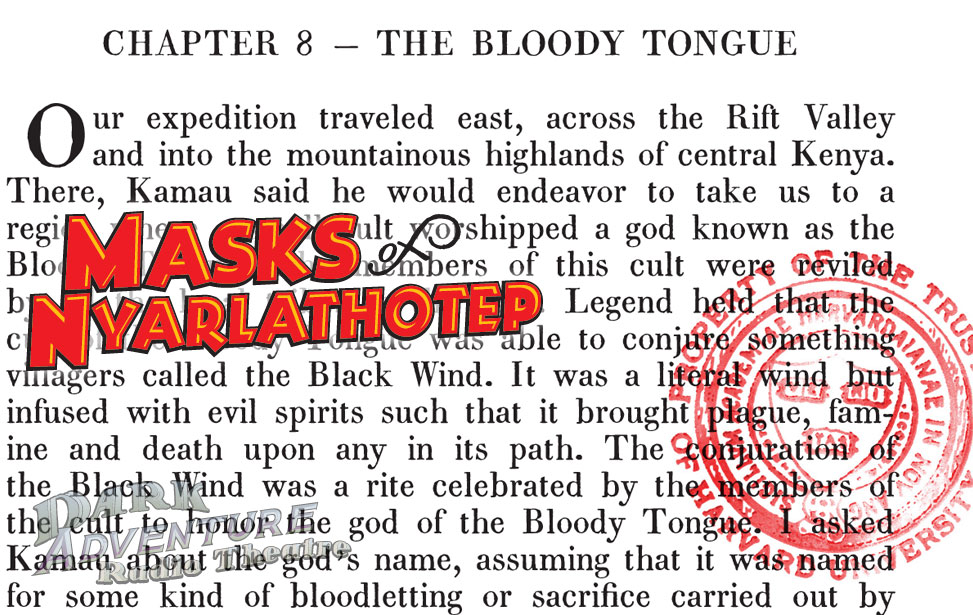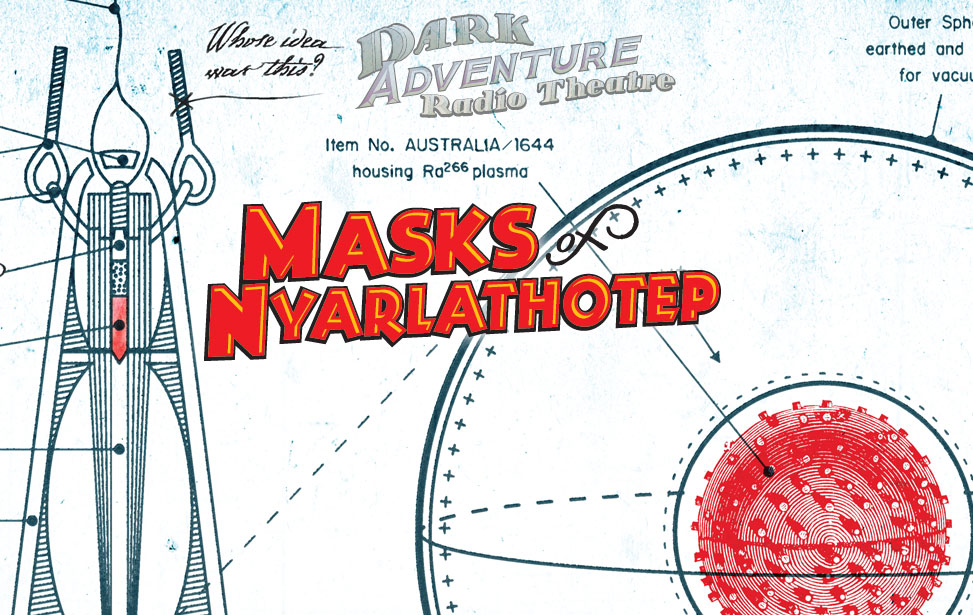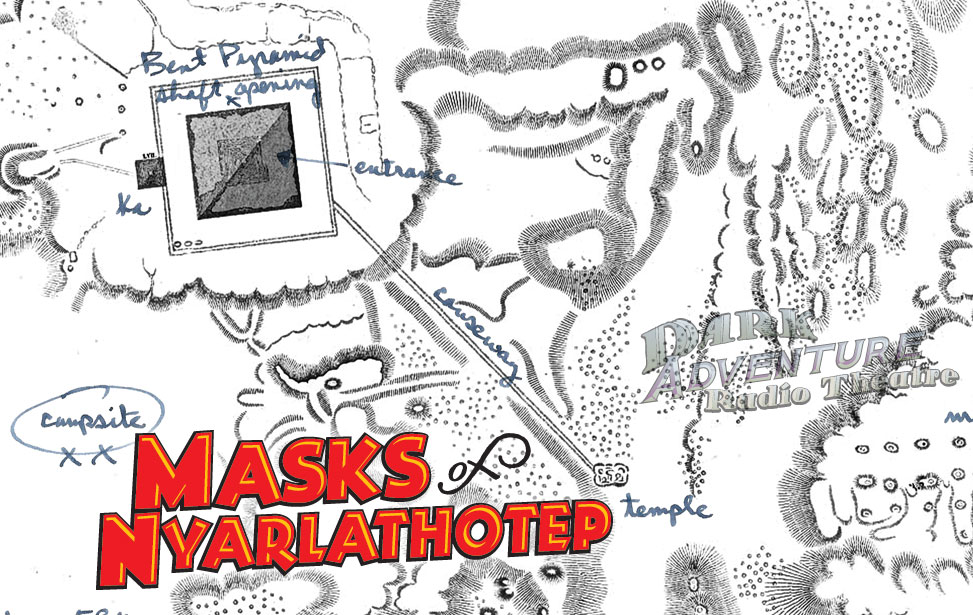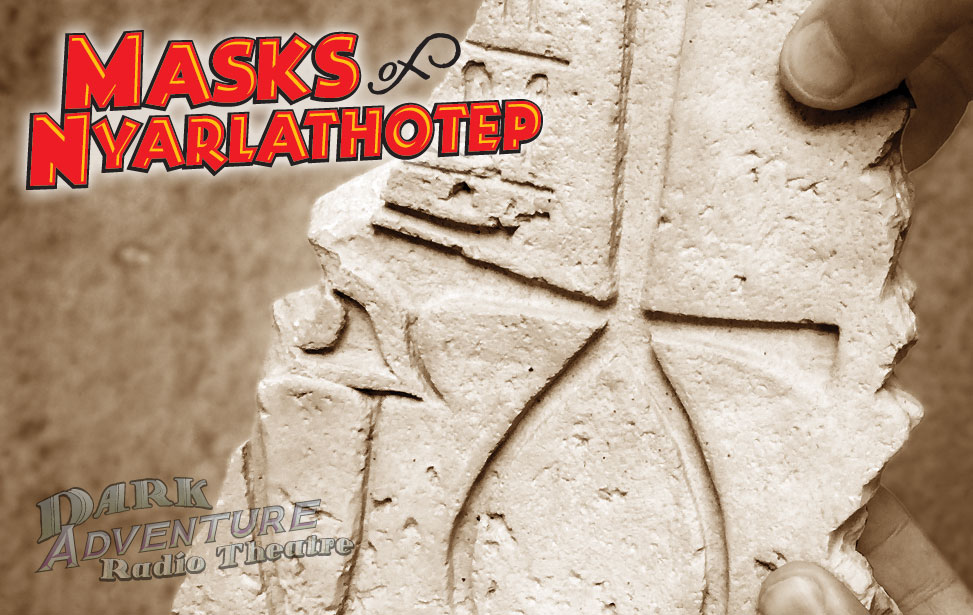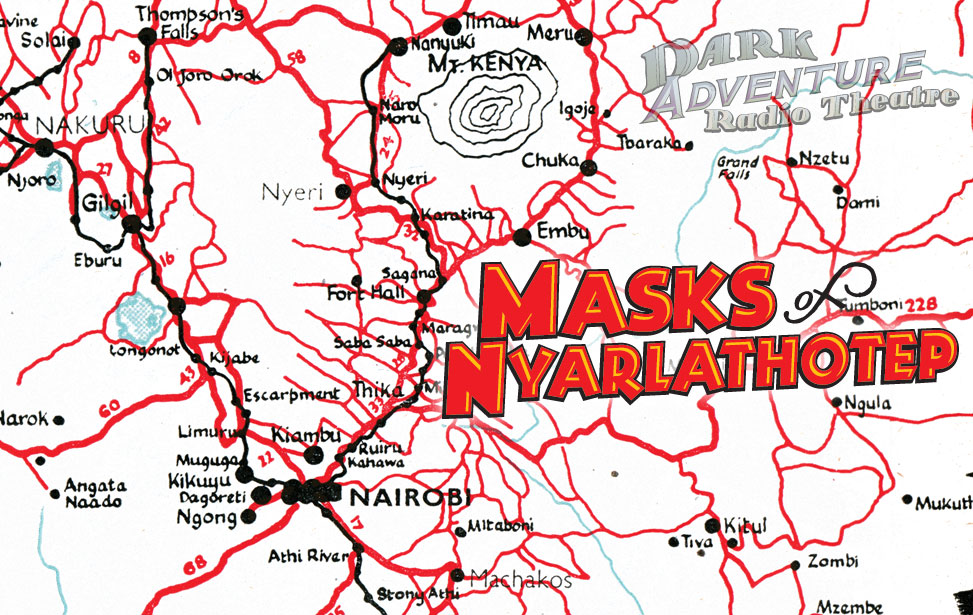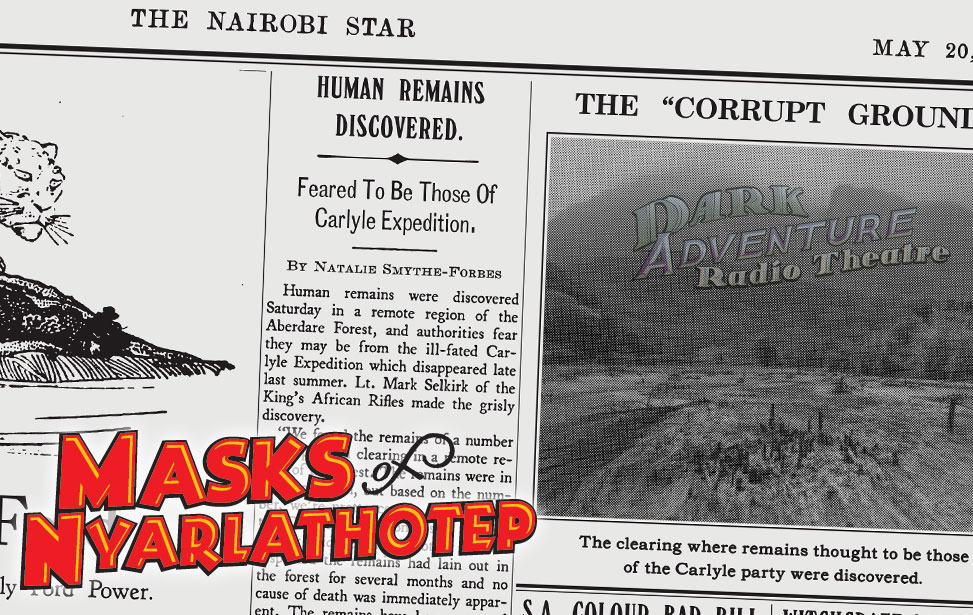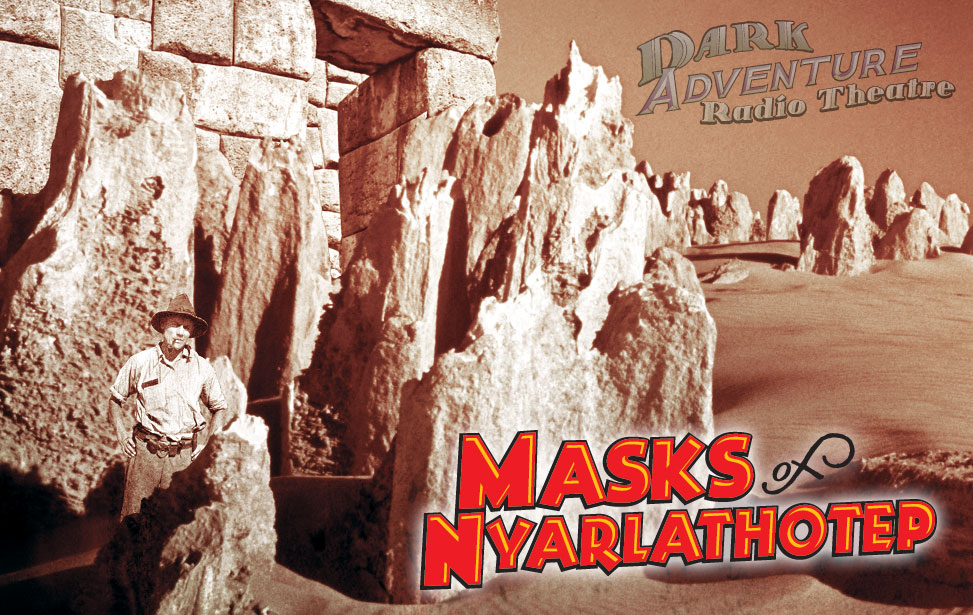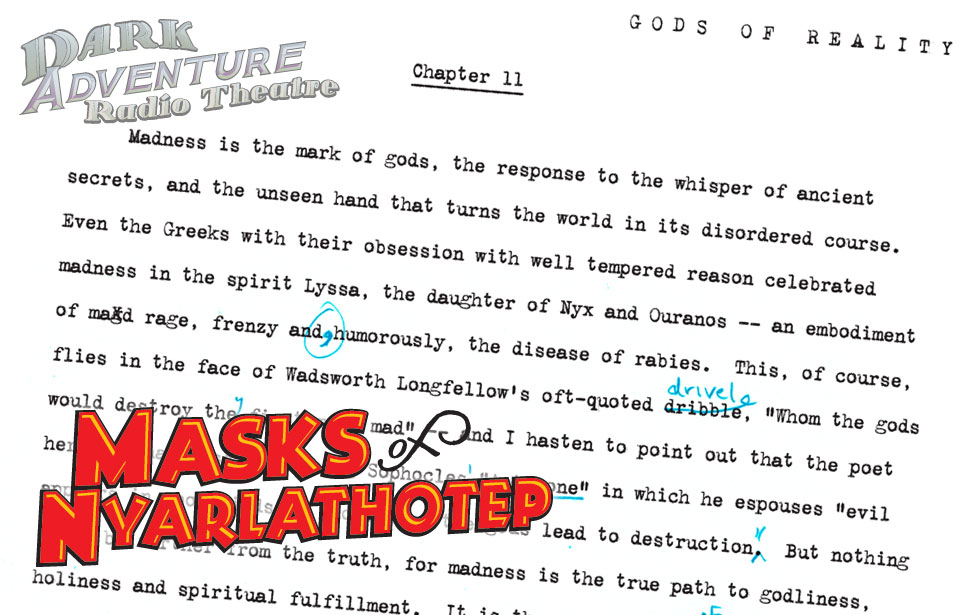Masks of Nyarlathotep Super Deluxe Limited Edition
Welcome to the "Masks of Nyarlathotep" Super Deluxe Limited Edition Elaboration Page. This page was set up specifically for owners of the Super Deluxe Edition to tell you more about the props and artifacts that come with the show. Here you’ll find source material, inspirations and other factoids that we hope will deepen your enjoyment of this very special HPLHS prop collection.
Many of the prop documents in the Super Deluxe Edition are also part of the Gamer Prop Set, but there are a number of things that happen in the game that do not happen in the show, and things happen in the show which are tied to our specific characters and their choices, so they are not likely to occur in anyone's playing of the game.
The prop documents are listed below in the sequence in which they are packaged in the Providence Trust Insurance case file. We imagine that this case file was prepared after the events of the story, and while it is generally organized geographically, some items might seem out of sequence. SPOILER ALERT! If you haven't yet listened to the show, viewing these props might spoil some plot surprises. Please proceed with caution.
The artifacts are listed in a separate panel below.
Get it now!The Super Deluxe Edition Props: Spoilers Ahead!
 Life insurance policies are very complex legal documents, and this prop version is an amalgamation of two or three real vintage policies. The original face value was one million dollars, but with the attached double indemnity rider the payout rises to $2,000,000. In 1924 that was worth almost thirty million bucks.
Life insurance policies are very complex legal documents, and this prop version is an amalgamation of two or three real vintage policies. The original face value was one million dollars, but with the attached double indemnity rider the payout rises to $2,000,000. In 1924 that was worth almost thirty million bucks.
Various irregularities with this particular policy stoked Cecil's suspicions that there was something fishy about Roger Carlyle's reported death....
 Cecil's letter is written after the events on Gray Dragon Island, but before his final visit to Victoria.
Cecil's letter is written after the events on Gray Dragon Island, but before his final visit to Victoria.
His investigator license is a fictionalized one, based on a prop originally designed for the motion picture Poodle Springs.
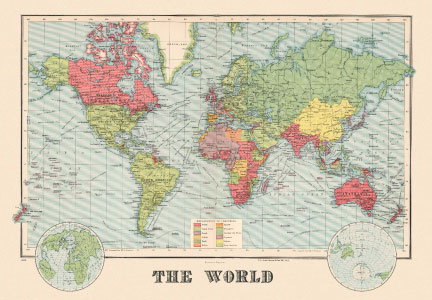 Cecil provided this map in the case file so his unimaginative bosses at Providence Trust could have some context for his work. Based on real vintage maps from 1923, this large format map has been edited to include a couple of locations from the story which did not appear on the original.
Cecil provided this map in the case file so his unimaginative bosses at Providence Trust could have some context for his work. Based on real vintage maps from 1923, this large format map has been edited to include a couple of locations from the story which did not appear on the original.
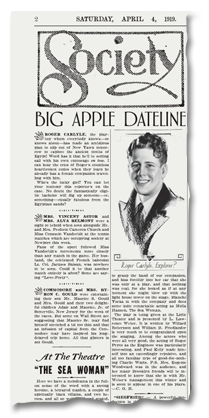 This is the first of several clippings culled by Cecil from The New York Pillar/Riposte, a delightful but fictional newspaper. Our design is inspired by a number of real New York City tabloids of the day, including the Amsterdam News. The image of Carlyle is that of a very famous young heartthrob of the day (he plays Carlyle in photos in other clippings as well), and other items in the society column were pulled from real papers of the day. The back side features news of the death of Sir William Crookes, who really did die that day in 1919, and a contemporary ad for Saks & Co.
This is the first of several clippings culled by Cecil from The New York Pillar/Riposte, a delightful but fictional newspaper. Our design is inspired by a number of real New York City tabloids of the day, including the Amsterdam News. The image of Carlyle is that of a very famous young heartthrob of the day (he plays Carlyle in photos in other clippings as well), and other items in the society column were pulled from real papers of the day. The back side features news of the death of Sir William Crookes, who really did die that day in 1919, and a contemporary ad for Saks & Co.
PLEASE NOTE: Your clipping may or may not be exactly the same size/shape as shown here. All the various newspaper clippings for this collection were designed and printed up in a giant full-size 12-page broadsheet newspaper. In order to get twice as many front pages, half of the newspaper is designed upside down. Our patient clipping shoggoths then meticulously disassemble these insanely complicated newspapers into the numerous different clippings, and there is always some variation in how specific individual clippings appear. All of the clippings include text and/or images on the reverse side, most pulled from actual newspapers from the time and place of the clipping itself.
 Rather than just a small clipping, we thought it would be fun to include an entire half page from the Pillar/Riposte so you could get the feel of reading the whole paper and seeing other news of the day. All of the other news items are real ones taken from New York newspapers from that time.
Rather than just a small clipping, we thought it would be fun to include an entire half page from the Pillar/Riposte so you could get the feel of reading the whole paper and seeing other news of the day. All of the other news items are real ones taken from New York newspapers from that time.
 By this time, we figured the story of the Carlyle Expedition was no longer front-page news, so this clipping comes from somewhere deeper inside the paper.
By this time, we figured the story of the Carlyle Expedition was no longer front-page news, so this clipping comes from somewhere deeper inside the paper.
 Once they've left New York, additional news of the expedition comes to the Pillar/Riposte by way of the Reuters agency, an international news-gathering agency that supplied newspapers worldwide. The Reuters agency was established in 1851 by Paul Julius Reuter, who in 1850 had developed a prototype news service using homing pigeons and electric telegraphy to transmit messages between Brussels and Aachen. Reuters was the first to report Abraham Lincoln's assassination in Europe in 1865. In 1883, Reuters began transmitting messages electrically to London newspapers. In 1923, Reuters began using radio to transmit news internationally, a pioneering act. The amusing story on the reverse of this clipping is a real item from a contemporary New York tabloid.
Once they've left New York, additional news of the expedition comes to the Pillar/Riposte by way of the Reuters agency, an international news-gathering agency that supplied newspapers worldwide. The Reuters agency was established in 1851 by Paul Julius Reuter, who in 1850 had developed a prototype news service using homing pigeons and electric telegraphy to transmit messages between Brussels and Aachen. Reuters was the first to report Abraham Lincoln's assassination in Europe in 1865. In 1883, Reuters began transmitting messages electrically to London newspapers. In 1923, Reuters began using radio to transmit news internationally, a pioneering act. The amusing story on the reverse of this clipping is a real item from a contemporary New York tabloid.
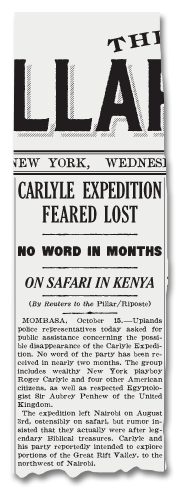 Now that the story is getting juicy again, news of the Carlyle Expedition returns to the front page of the Pillar/Riposte.
Now that the story is getting juicy again, news of the Carlyle Expedition returns to the front page of the Pillar/Riposte.
 The item above the Carlyle clipping is a real verbatim news item from the time, and it is interesting to note that all of the women in the story are referred to exclusively by their husband's names. Erica Carlyle is the only woman in the clipping with her own identity. The back of the clipping features an ad that might be familiar to listeners of Dark Adventure Radio Theatre.
The item above the Carlyle clipping is a real verbatim news item from the time, and it is interesting to note that all of the women in the story are referred to exclusively by their husband's names. Erica Carlyle is the only woman in the clipping with her own identity. The back of the clipping features an ad that might be familiar to listeners of Dark Adventure Radio Theatre.
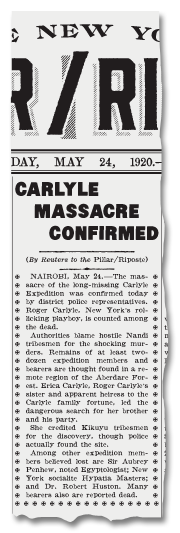 This page-one item is surrounded by crosses, which was done in some newspapers to highlight stories about the death of prominent figures, such as political assassinations. The mad-looking gentleman pictured on the back of the clipping is John Armstrong Chaloner, a fascinating figure of the 1920s who is mentioned in one of the items on the full half-page clipping. You can learn more about him here.
This page-one item is surrounded by crosses, which was done in some newspapers to highlight stories about the death of prominent figures, such as political assassinations. The mad-looking gentleman pictured on the back of the clipping is John Armstrong Chaloner, a fascinating figure of the 1920s who is mentioned in one of the items on the full half-page clipping. You can learn more about him here.
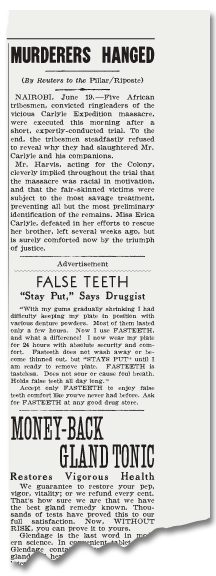 A subsequent clipping in the Africa folder covers this same story in somewhat more detail.
A subsequent clipping in the Africa folder covers this same story in somewhat more detail.
 Cecil placed this telegram that Jackson sent to Hazel in Jackson's own folder on the Carlyle case, recovered from his room at the Chelsea hotel. The prop is a replica of a real telegram from the Postal Telegraph Company, which was a major US telegram company that competed with Western Union in the 1920s. The data at the top of the telegram is the "check", which shows that the message was sent from aboard a steamship called the Phalerope.
Cecil placed this telegram that Jackson sent to Hazel in Jackson's own folder on the Carlyle case, recovered from his room at the Chelsea hotel. The prop is a replica of a real telegram from the Postal Telegraph Company, which was a major US telegram company that competed with Western Union in the 1920s. The data at the top of the telegram is the "check", which shows that the message was sent from aboard a steamship called the Phalerope.
This version is different than the one included in the Gamer Prop Set, which is somewhat more vague and not addressed to anyone specific so it can be used by any character.
 This is one of the items recovered from Jackson Elias' hotel room in New York City, and is one of the core props of the story. This handwritten letter came into Elias' possession via Jack Brady, and if it's a little bit crumpled it's because it has travelled around the world in Brady's pocket. Our thanks to HPLHS Member Jay Stigdon for providing the penmanship of Warren Besart with a real fountain pen.
This is one of the items recovered from Jackson Elias' hotel room in New York City, and is one of the core props of the story. This handwritten letter came into Elias' possession via Jack Brady, and if it's a little bit crumpled it's because it has travelled around the world in Brady's pocket. Our thanks to HPLHS Member Jay Stigdon for providing the penmanship of Warren Besart with a real fountain pen.
 This is another of the items recovered from Elias' hotel room. Elias' handwriting on the back is based on the handwriting of H.P. Lovecraft himself.
This is another of the items recovered from Elias' hotel room. Elias' handwriting on the back is based on the handwriting of H.P. Lovecraft himself.
 This is another item found in Elias' hotel room. The linen finish is the choice of insane villains everywhere. The hieroglyphics spell "Penhew", and the cartouche is an inverted ankh, which is sinister to those in the know.
This is another item found in Elias' hotel room. The linen finish is the choice of insane villains everywhere. The hieroglyphics spell "Penhew", and the cartouche is an inverted ankh, which is sinister to those in the know.
 We decided to do a box of matches rather than a book for a few different reasons. It somehow feels more 1920s to us, plus if you want you can empty out the matches and hide some other kind of clue inside the box. Also, we did a matchbook for the Innsmouth House hotel for our Dark Adventure Radio Theatre episode of "The Shadow Over Innsmouth", and we wanted to try something different.
We decided to do a box of matches rather than a book for a few different reasons. It somehow feels more 1920s to us, plus if you want you can empty out the matches and hide some other kind of clue inside the box. Also, we did a matchbook for the Innsmouth House hotel for our Dark Adventure Radio Theatre episode of "The Shadow Over Innsmouth", and we wanted to try something different.
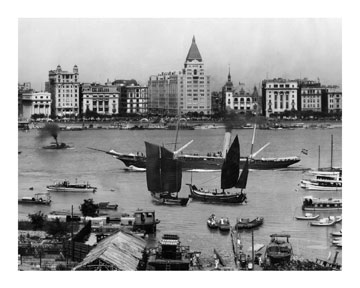 Elias presumably got this photo from Jack Brady. The background features just a small section of a slightly anachronistic but lovely panoramic 1929 photo of the Bund in Shanghai, taken from Pootung Point. The tall building with the pointed roof is the Sassoon House, one of the first skyscrapers built in the Eastern Hemisphere, and home of the Cathay Hotel. The gothic looking building to its right is the Club Concordia, which is labeled on the Shanghai map. Most of the boats in the river are from the original photo, but the Dark Mistress itself was composited in, as were the junks partially obscuring it from view. (The Dark Mistress is actually a steam yacht from 1893 called the May.)
Elias presumably got this photo from Jack Brady. The background features just a small section of a slightly anachronistic but lovely panoramic 1929 photo of the Bund in Shanghai, taken from Pootung Point. The tall building with the pointed roof is the Sassoon House, one of the first skyscrapers built in the Eastern Hemisphere, and home of the Cathay Hotel. The gothic looking building to its right is the Club Concordia, which is labeled on the Shanghai map. Most of the boats in the river are from the original photo, but the Dark Mistress itself was composited in, as were the junks partially obscuring it from view. (The Dark Mistress is actually a steam yacht from 1893 called the May.)
 This is the last of the clues personally collected by Jackson Elias and recovered from his room at the Hotel Chelsea. Jackson intended to travel to Australia, but of course he never made it that far....
This is the last of the clues personally collected by Jackson Elias and recovered from his room at the Hotel Chelsea. Jackson intended to travel to Australia, but of course he never made it that far....

 The Hotel Chelsea was, and hopefully will remain, a very real New York icon. Opened in 1885, it has been the home of numerous famous people and the scene of a number of notable deaths. It has been closed for renovations since 2011 and is scheduled to reopen in 2019.
The Hotel Chelsea was, and hopefully will remain, a very real New York icon. Opened in 1885, it has been the home of numerous famous people and the scene of a number of notable deaths. It has been closed for renovations since 2011 and is scheduled to reopen in 2019.
We didn't have any luck finding a sample of real Hotel Chelsea letterhead from the 1920s, so this is a fictionalized version using an image of the hotel from a postcard augmented with vintage automobiles, and information from vintage advertisements.
 Jomo, the cultist who killed Jackson Elias, was wearing a headband like this one in the Hotel Chelsea. This particular headband is one that Cecil recovered during the big fight in the basement of the Ju-Ju House, and is typical of the uniform of the lower-level New York cultists. During the basement rituals, they were stark naked except for this crude fabric representation of a tongue. The high-level cultists were draped with actual human tongues that had been severed from previous victims.
Jomo, the cultist who killed Jackson Elias, was wearing a headband like this one in the Hotel Chelsea. This particular headband is one that Cecil recovered during the big fight in the basement of the Ju-Ju House, and is typical of the uniform of the lower-level New York cultists. During the basement rituals, they were stark naked except for this crude fabric representation of a tongue. The high-level cultists were draped with actual human tongues that had been severed from previous victims.
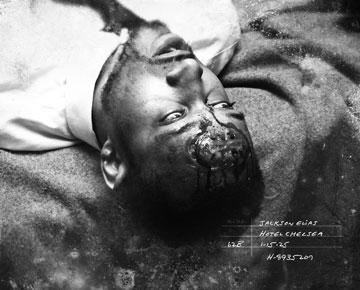 Lt. Poole's team took this picture at the Hotel Chelsea, and Cecil obtained a copy via formal request. Our thanks to Special Makeup Effects wizard Dave Snyder for doing the makeup, and to actor Samir Shakur for playing Jackson Elias.
Lt. Poole's team took this picture at the Hotel Chelsea, and Cecil obtained a copy via formal request. Our thanks to Special Makeup Effects wizard Dave Snyder for doing the makeup, and to actor Samir Shakur for playing Jackson Elias.
For a video of the makeup being applied, CLICK HERE
For another video of the makeup being applied, CLICK HERE
 This is a clipping from The New York Times with the article by Rebecca Shosenburg. It was rather unusual for reporters to get a byline for a news item in the Times in 1925. The story on the back of the clipping is a real news item from the NYT of that day.
This is a clipping from The New York Times with the article by Rebecca Shosenburg. It was rather unusual for reporters to get a byline for a news item in the Times in 1925. The story on the back of the clipping is a real news item from the NYT of that day.
 Jackson Elias was blessed with many good friends, and we thought it would be nice to include this page from the condolence book from his funeral. The condolence book was kept by Jonah Kensington, and Cecil requested it when he was assembling his case file. Kensington agreed to give him this single page to demonstrate the quality of Jackson's friendships.
Jackson Elias was blessed with many good friends, and we thought it would be nice to include this page from the condolence book from his funeral. The condolence book was kept by Jonah Kensington, and Cecil requested it when he was assembling his case file. Kensington agreed to give him this single page to demonstrate the quality of Jackson's friendships.
The signers are a mix of historical figures who might have known Jackson, fictional characters, and fictionalized versions of present-day people. All the signatures of historical figures are replicas of their actual autographs. You can learn more about them at the following links:
Scott Dorward, Paul Fricker and Matthew Sanderson
We were very saddened by the passing of Greg Stafford while we were working on this episode and wanted to include him in tribute. The episode is dedicated to him and to Larry DiTillio.
 Jackson Elias had several books published by Prospero House before his death, and we thought a fun way to provide a more detailed look at his writing career would be through the dust jacket for his most recent. The Hungry Dead covers the last case he investigated with Zeke Ford by his side.
Jackson Elias had several books published by Prospero House before his death, and we thought a fun way to provide a more detailed look at his writing career would be through the dust jacket for his most recent. The Hungry Dead covers the last case he investigated with Zeke Ford by his side.
Of course we have no idea what books you might have in your library, but this dust jacket is designed to fit over the Arkham House hardback edition of At the Mountains of Madness. It should fit over any number of other more or less standard sized books as well.
 We thought it would be fun if Jackson's final letter to his publisher was written on letterhead from one of the last hotels he stayed in: the Hampton House in Nairobi. Elias' handwriting is based on that of H.P. Lovecraft.
We thought it would be fun if Jackson's final letter to his publisher was written on letterhead from one of the last hotels he stayed in: the Hampton House in Nairobi. Elias' handwriting is based on that of H.P. Lovecraft.
 We wanted to provide a look into the workings of Prospero House, Elias' publisher, as well as a more complete view into Jackson's thinking, so we present Elias' Nairobi notes in the form of an official in-house summary on Prospero House letterhead.
We wanted to provide a look into the workings of Prospero House, Elias' publisher, as well as a more complete view into Jackson's thinking, so we present Elias' Nairobi notes in the form of an official in-house summary on Prospero House letterhead.
 The last set of notes Cecil got from Jonah Kensington. Having established that Elias uses letterhead from the various hotels where he stays, we invented one for London. The address is a nod to a flat where Sean Branney and Andrew Leman stayed during a trip to London in 1988. The handwriting is based on that of H.P. Lovecraft.
The last set of notes Cecil got from Jonah Kensington. Having established that Elias uses letterhead from the various hotels where he stays, we invented one for London. The address is a nod to a flat where Sean Branney and Andrew Leman stayed during a trip to London in 1988. The handwriting is based on that of H.P. Lovecraft.
 This is the file that Cecil got from the New York Medical Affairs Board, detailing Carlyle's therapy with Dr. Huston. It reveals at least as much about the doctor himself....
This is the file that Cecil got from the New York Medical Affairs Board, detailing Carlyle's therapy with Dr. Huston. It reveals at least as much about the doctor himself....
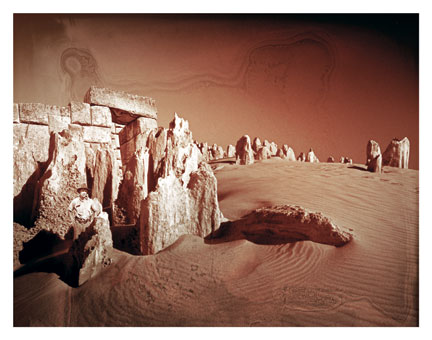 This is the photo Professor Cowles gave to Hazel. It shows MacWhirr standing in front of some very curious geological/architectural formations in Western Australia. The photo is a composite that includes stones from The Pinnacles, which is an actual Australian geological formation, along with the ruins of a cyclopean Inca fortress in Cusco, Peru. MacWhirr is portrayed by the real Australian explorer Michael Terry.
This is the photo Professor Cowles gave to Hazel. It shows MacWhirr standing in front of some very curious geological/architectural formations in Western Australia. The photo is a composite that includes stones from The Pinnacles, which is an actual Australian geological formation, along with the ruins of a cyclopean Inca fortress in Cusco, Peru. MacWhirr is portrayed by the real Australian explorer Michael Terry.
 This is one particularly interesting page from the book Cecil finds in the Ju-Ju House, and which Hazel reads on the trip over to England. It would seem that Cecil never did get around to returning it to the Harvard library....
This is one particularly interesting page from the book Cecil finds in the Ju-Ju House, and which Hazel reads on the trip over to England. It would seem that Cecil never did get around to returning it to the Harvard library....
 Victoria brought this clipping with her to London to show her fellow investigators, and it provides a little coda to the New York section of the story. While we are not particularly comfortable with the use of the word "negro", it was standard language in the New York Times of the 1920s. All the other articles appearing in the clipping are taken from the actual newspaper of that day.
Victoria brought this clipping with her to London to show her fellow investigators, and it provides a little coda to the New York section of the story. While we are not particularly comfortable with the use of the word "negro", it was standard language in the New York Times of the 1920s. All the other articles appearing in the clipping are taken from the actual newspaper of that day.
 Cecil managed to get this booking slip with the help of Lt. Poole after Victoria's arrest was voided. Victoria Woodhull did indeed have run-ins with the law before, having been arrested in 1872 (along with her husband Colonel James Blood and her sister Tennessee) as a result of an article published in their newspaper. The resulting trial led to the passage of the Comstock Laws, making it a federal crime to use the U.S. Mail to send "obscene" materials. This mug shot is a composite of actor Kacey Camp's face with a genuine 1920s police photo from Australia.
Cecil managed to get this booking slip with the help of Lt. Poole after Victoria's arrest was voided. Victoria Woodhull did indeed have run-ins with the law before, having been arrested in 1872 (along with her husband Colonel James Blood and her sister Tennessee) as a result of an article published in their newspaper. The resulting trial led to the passage of the Comstock Laws, making it a federal crime to use the U.S. Mail to send "obscene" materials. This mug shot is a composite of actor Kacey Camp's face with a genuine 1920s police photo from Australia.
 Victoria and her sister Tennessee founded this newspaper in 1870 and published it for six years. Its original purpose was to help in Victoria's bid for the U.S. Presidency, but they kept it going after that campaign ended for as long as they could. It was the first U.S. publication to publish Karl Marx's Communist Manifesto in English. It was considered so scandalous at the time that they received numerous threats and had to shut down and move offices. Cecil asked Victoria for a copy of an old issue, and included it in the case file for added context.
Victoria and her sister Tennessee founded this newspaper in 1870 and published it for six years. Its original purpose was to help in Victoria's bid for the U.S. Presidency, but they kept it going after that campaign ended for as long as they could. It was the first U.S. publication to publish Karl Marx's Communist Manifesto in English. It was considered so scandalous at the time that they received numerous threats and had to shut down and move offices. Cecil asked Victoria for a copy of an old issue, and included it in the case file for added context.
This prop is a composite of real articles from several different issues, written by both Victoria and Tennessee. Many issues are archived online by the International Association for the Preservation of Spiritualist and Occult Periodicals.
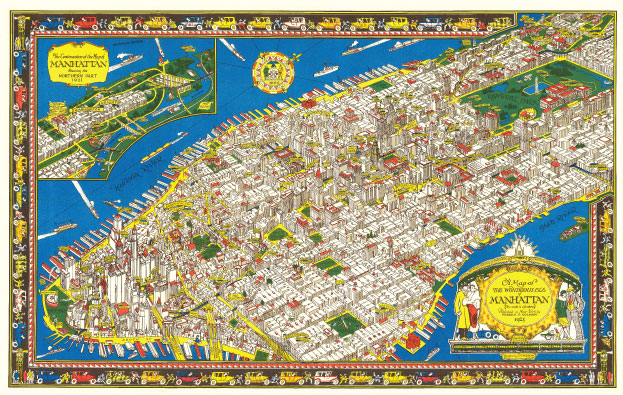 This large-format prop is an edited replica of an amazingly detailed and whimsical map of New York City drawn by Charles Vernon Farrow and distributed by the Washington Square Bookshop in 1926. The Washington Square Bookshop was a vibrant location in Greenwich Village, and in the 1920s and '30s, under the direction of co-owner Josephine Bell Horton, published a number of pictorial maps. Although it is beautiful, it does conspicuously skip over Harlem....
This large-format prop is an edited replica of an amazingly detailed and whimsical map of New York City drawn by Charles Vernon Farrow and distributed by the Washington Square Bookshop in 1926. The Washington Square Bookshop was a vibrant location in Greenwich Village, and in the 1920s and '30s, under the direction of co-owner Josephine Bell Horton, published a number of pictorial maps. Although it is beautiful, it does conspicuously skip over Harlem....
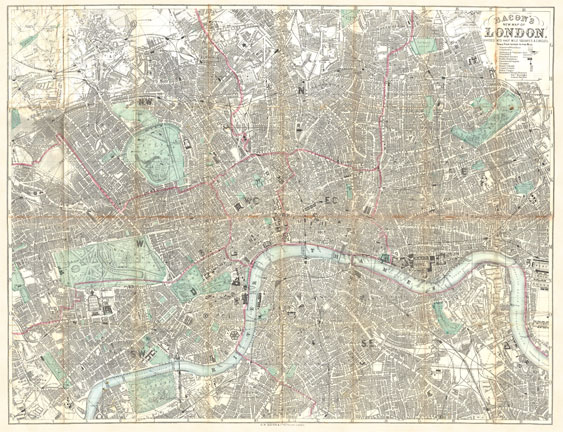 This large-format map is a cleaned-up replica of a real one from 1890. Although it is a little bit out of date for 1925, Cecil includes it in the case file because it shows the city from Soho to the Limehouse Reach, encompassing many important locations.
This large-format map is a cleaned-up replica of a real one from 1890. Although it is a little bit out of date for 1925, Cecil includes it in the case file because it shows the city from Soho to the Limehouse Reach, encompassing many important locations.
The Penhew Foundation is located at about L9 on the map, near the corner of Tottenham Court Road and Percy Street.
Victoria's flat is at about M8, in Brook's Mews.
The warehouse where Cecil and Gupta meet Billee is at about M18, in Ropemakers Field.
The Blue Pyramid Club and Empire Spices are at about M9, in Soho.
 The Scoop is a delightful but fictional British tabloid. Our design is inspired by a number of real London tabloids of the day, including the Pall Mall Gazette. For each of the various newspapers represented in the collection, we wanted at least one clipping to be a full half page, so you could get a sense of the whole paper and see some other news of the day. The other sensational items in this prop are all lifted from British tabloids of 1924. Our thanks to HPLHS Member David G. Cercone II for spending hours in the microfilm department of the Library of Congress in Washington DC, getting samples from The Daily Mail, The Star, and The Sphere.
The Scoop is a delightful but fictional British tabloid. Our design is inspired by a number of real London tabloids of the day, including the Pall Mall Gazette. For each of the various newspapers represented in the collection, we wanted at least one clipping to be a full half page, so you could get a sense of the whole paper and see some other news of the day. The other sensational items in this prop are all lifted from British tabloids of 1924. Our thanks to HPLHS Member David G. Cercone II for spending hours in the microfilm department of the Library of Congress in Washington DC, getting samples from The Daily Mail, The Star, and The Sphere.
 Hazel Claflin is a fictional member of a real family, and this letter gives a number of real biographical details about her parents and her cousins. Bill Claflin was affiliated with the Peabody Museum, but we couldn't find any real letterhead from the 1920s, so this prop is a fictionalized version based on comparable institutions of the time. Hazel gave Cecil this copy of the letter for his file.
Hazel Claflin is a fictional member of a real family, and this letter gives a number of real biographical details about her parents and her cousins. Bill Claflin was affiliated with the Peabody Museum, but we couldn't find any real letterhead from the 1920s, so this prop is a fictionalized version based on comparable institutions of the time. Hazel gave Cecil this copy of the letter for his file.
 Although this prop is not specifically mentioned in the show, it's a document that Hazel managed to sneak off of Gavigan's desk while Victoria kept him occupied with her doddering old woman act.
Although this prop is not specifically mentioned in the show, it's a document that Hazel managed to sneak off of Gavigan's desk while Victoria kept him occupied with her doddering old woman act.
The prop is a replica of a real vintage British telegram. In England, the General Post Office was granted an official monopoly on all telegraph services starting in 1870, and in the 1920s the GPO was in charge of telegrams, phone calls, and radio broadcasts.
 Knowing that Cecil could use documents of this kind, this is another paper that Hazel managed to nab while Victoria distracted Gavigan. The £108 paid for the "walk-in safe" noted on this receipt would be about $8600 in today's money, according to Eric W. Nye, Pounds Sterling to Dollars: Historical Conversion of Currency.
Knowing that Cecil could use documents of this kind, this is another paper that Hazel managed to nab while Victoria distracted Gavigan. The £108 paid for the "walk-in safe" noted on this receipt would be about $8600 in today's money, according to Eric W. Nye, Pounds Sterling to Dollars: Historical Conversion of Currency.
 Cecil obtained this copy of Barrington's write-up of their interview through a formal records request. Scotland Yard pioneered modern police procedure, and this prop is a replica of real British police records of the time. (The rubber stamp at the bottom is taken from one of the reports about Jack the Ripper.) Our sincere thanks to Chris Lackey for his efforts to help us get a look at real British police documents, and to the very helpful folks at the Friends of the Metropolitan Police Historical Collection for their detailed information on how police record-keeping was done.
Cecil obtained this copy of Barrington's write-up of their interview through a formal records request. Scotland Yard pioneered modern police procedure, and this prop is a replica of real British police records of the time. (The rubber stamp at the bottom is taken from one of the reports about Jack the Ripper.) Our sincere thanks to Chris Lackey for his efforts to help us get a look at real British police documents, and to the very helpful folks at the Friends of the Metropolitan Police Historical Collection for their detailed information on how police record-keeping was done.
 Printed cocktail napkins first appeared in Britain in 1887. The napkins themselves were originally imported from Japan, and then locally printed with commemorative designs and information. By the 1920s they were in common use. This is the napkin that Yalesha left for Hazel and Zeke at the Blue Pyramid club in Soho.
Printed cocktail napkins first appeared in Britain in 1887. The napkins themselves were originally imported from Japan, and then locally printed with commemorative designs and information. By the 1920s they were in common use. This is the napkin that Yalesha left for Hazel and Zeke at the Blue Pyramid club in Soho.
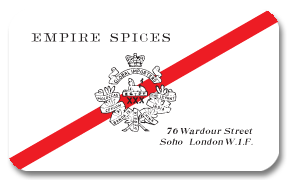 Cecil grabbed this card while he and Victoria were searching Zahra Shafik's shop. The Empire Spices logo names a number of exotic locales from which various spices were imported.
Cecil grabbed this card while he and Victoria were searching Zahra Shafik's shop. The Empire Spices logo names a number of exotic locales from which various spices were imported.
 This is the receipt that Cecil finds in Zahra Shafik's private flat at Empire Spices, which leads the team on to Derby.
This is the receipt that Cecil finds in Zahra Shafik's private flat at Empire Spices, which leads the team on to Derby.
 Although this label is actually one that Cecil recovered in the Randolph Shipping warehouse in Australia, he filed it here among the English documents because of its connection to Henson Manufacturing.
Although this label is actually one that Cecil recovered in the Randolph Shipping warehouse in Australia, he filed it here among the English documents because of its connection to Henson Manufacturing.
 These are the plans that Zeke recovers from the Henson Manufacturing workshop in Derby. Cecil notes similarities in the handwriting of the notations to words written on Carlyle's life insurance policy that lead to a startling conclusion. The blueprints are based on real vintage German sketches of a theoretical uranium bomb.
These are the plans that Zeke recovers from the Henson Manufacturing workshop in Derby. Cecil notes similarities in the handwriting of the notations to words written on Carlyle's life insurance policy that lead to a startling conclusion. The blueprints are based on real vintage German sketches of a theoretical uranium bomb.
 This item is not specifically referenced in the show, but it's one of a handful of documents Cecil nabbed from Gavigan's desk in Misr House. We find ourselves wondering why Gavigan stopped this letter mid-sentence, and what he would have gone on to write.
This item is not specifically referenced in the show, but it's one of a handful of documents Cecil nabbed from Gavigan's desk in Misr House. We find ourselves wondering why Gavigan stopped this letter mid-sentence, and what he would have gone on to write.
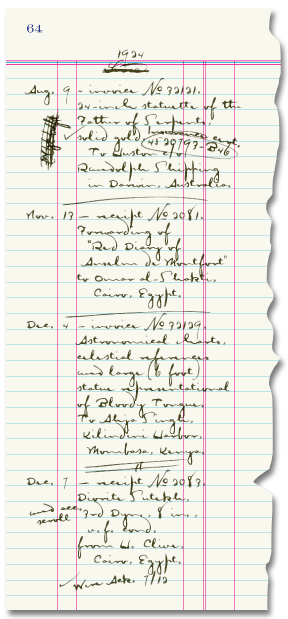 Also not specifically referenced in the show, Cecil tore this page from Gavigan's ledger during the few panicky moments he and Zeke and Hazel were searching Gavigan's office at Misr House. These are the kinds of documents Cecil loves. Gavigan's handwriting is based on that of American poet Sidney Lanier.
Also not specifically referenced in the show, Cecil tore this page from Gavigan's ledger during the few panicky moments he and Zeke and Hazel were searching Gavigan's office at Misr House. These are the kinds of documents Cecil loves. Gavigan's handwriting is based on that of American poet Sidney Lanier.
 This is the letter Cecil pulls from Gavigan's desk drawer. Al-Shakti's letterhead features metallic gold ink on Havilland Blue linen finish paper, marking him as a true supervillain.
This is the letter Cecil pulls from Gavigan's desk drawer. Al-Shakti's letterhead features metallic gold ink on Havilland Blue linen finish paper, marking him as a true supervillain.
The calligraphic design at the top is a Basmala, which is Arabic for "In the name of God", although in al-Shakti's case that doesn't really refer to Allah. The Basmala is the first phrase of the Quran and is a frequent subject for ornate calligraphy.
 The Cairo Bulletin is a fictional newspaper, but this design is based on a real one, The Egyptian Gazette. This half-page clipping includes real ads and news items taken from contemporary issues of the Gazette. It was not uncommon for the front pages of British colonial newspapers to be entirely devoted to ads, and comparatively rare to run such a large photograph, but we thought this would be a good place to include a picture of the Carlyle Expedition group, and this is a doctored photo of a real group of 1920s Egyptologists. Our thanks again to HPLHS Member David G. Cercone II for doing research at the Library of Congress.
The Cairo Bulletin is a fictional newspaper, but this design is based on a real one, The Egyptian Gazette. This half-page clipping includes real ads and news items taken from contemporary issues of the Gazette. It was not uncommon for the front pages of British colonial newspapers to be entirely devoted to ads, and comparatively rare to run such a large photograph, but we thought this would be a good place to include a picture of the Carlyle Expedition group, and this is a doctored photo of a real group of 1920s Egyptologists. Our thanks again to HPLHS Member David G. Cercone II for doing research at the Library of Congress.
 Another item from The Cairo Bulletin, chronicling the comings and goings of Carlyle's group.
Another item from The Cairo Bulletin, chronicling the comings and goings of Carlyle's group.

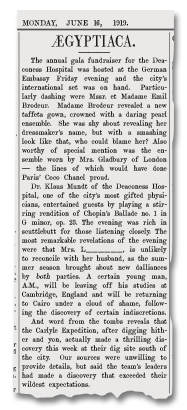 A gossip column from The Cairo Bulletin that touches on the Carlyle party. The story on the back about the dog is a real one.
A gossip column from The Cairo Bulletin that touches on the Carlyle party. The story on the back about the dog is a real one.
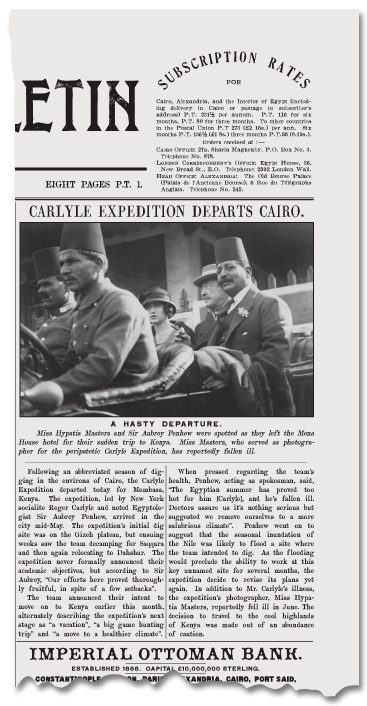 We could not resist including just one more clipping from The Cairo Bulletin when we saw this photo. We think the guys in the fezzes are members of the Brotherhood of the Black Pharaoh, getting Hypatia out of town before any more photographers can snap forbidden pictures of her....
We could not resist including just one more clipping from The Cairo Bulletin when we saw this photo. We think the guys in the fezzes are members of the Brotherhood of the Black Pharaoh, getting Hypatia out of town before any more photographers can snap forbidden pictures of her....
 Shepheard's Hotel was the most luxurious hotel in Cairo from its opening in the 1840s until it burned down, along with a lot of other things, during riots in 1952. This fictionalized claim check is based on real Shepheard's letterhead. We apologize in advance for any errors you may detect in the French and Arabic translations....
Shepheard's Hotel was the most luxurious hotel in Cairo from its opening in the 1840s until it burned down, along with a lot of other things, during riots in 1952. This fictionalized claim check is based on real Shepheard's letterhead. We apologize in advance for any errors you may detect in the French and Arabic translations....
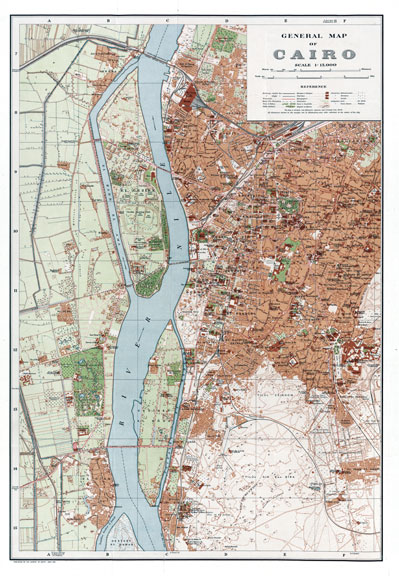 This large-format map is a replica of a portion of a real one from 1920. Cecil bought it in the lobby of Shepheard's Hotel.
This large-format map is a replica of a portion of a real one from 1920. Cecil bought it in the lobby of Shepheard's Hotel.
Shepheard's can be found in the bottom left corner of E9.
The Egyptian Museum is on the left side of D10.
The Mosque of Ibn Tulun is in E12.
The Street of Scorpions, where Zeke and Hazel meet Warren Besart, is in F11.
The Street of Potters, where Zeke and Cecil talk to Faraz Najjar, is in G10, at the very rightmost edge of the map.
The Deaconess Hospital is in C14, in Old Cairo.
 Zeke wrote this note in a terrible hurry, using a borrowed pencil and a piece of paper he just happened to have in his pocket: the cover for a pack of Kyriazi Frères cigarette rolling papers.
Zeke wrote this note in a terrible hurry, using a borrowed pencil and a piece of paper he just happened to have in his pocket: the cover for a pack of Kyriazi Frères cigarette rolling papers.
 This prop is a fictionalized design based on several different examples of real Egyptian telegrams from the early 20th century.
This prop is a fictionalized design based on several different examples of real Egyptian telegrams from the early 20th century.
 Cecil snapped this photo of Zeke holding Nuri's half of the Eye of Light and Darkness when Zeke and Dr. Kafour brought it back from El Wasta.
Cecil snapped this photo of Zeke holding Nuri's half of the Eye of Light and Darkness when Zeke and Dr. Kafour brought it back from El Wasta.
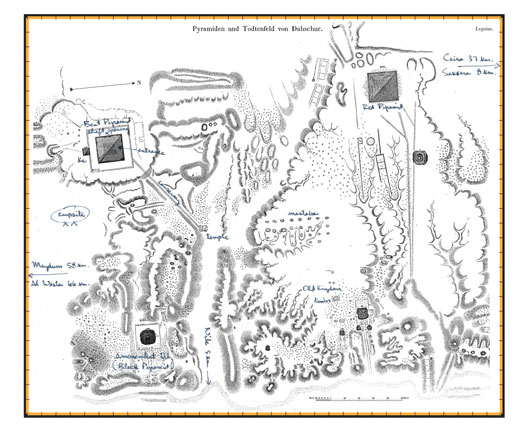 Although not specifically referenced in the show, Zeke and Hazel got this map directly from Warren Besart. He was glad to sell it for more hashish money. Besart originally prepared it for the Carlyle expedition, and annotated it with various sites of importance at Dahshur, including the Bent Pyramid and the Red Pyramid.
Although not specifically referenced in the show, Zeke and Hazel got this map directly from Warren Besart. He was glad to sell it for more hashish money. Besart originally prepared it for the Carlyle expedition, and annotated it with various sites of importance at Dahshur, including the Bent Pyramid and the Red Pyramid.
This prop is an edited version of a map by the pioneering German Egyptologist Karl Lepsius, who published a massive encyclopedic study of Ancient Egyptian sites in the 1840s. Our thanks again to HPLHS Member Jay Stigdon for providing Besart's penmanship.
 Cecil made this rubbing of the complete Eye of Light and Darkness after Dr. Kafour and Mu Hsien restored it in Shanghai, but he filed it here because of its Egyptian origins. Dr. Kafour provided some handwritten notations to Cecil's rubbing.
Cecil made this rubbing of the complete Eye of Light and Darkness after Dr. Kafour and Mu Hsien restored it in Shanghai, but he filed it here because of its Egyptian origins. Dr. Kafour provided some handwritten notations to Cecil's rubbing.
 Cecil made this hasty sketch of the strange map the team discovered carved into the wall of Nyarlathotep's throne room in the Bent Pyramid. He used the biggest piece of paper he happened to have on him, which was the bill from the Deaconess Hospital. Dr. Kafour made a few notations along the bottom.
Cecil made this hasty sketch of the strange map the team discovered carved into the wall of Nyarlathotep's throne room in the Bent Pyramid. He used the biggest piece of paper he happened to have on him, which was the bill from the Deaconess Hospital. Dr. Kafour made a few notations along the bottom.
The ancient Egyptians drew maps with south on top, so that's how this map is orientated. The dark curved line shows the path of the total solar eclipse of 1926. The rest of the design is based on a map of the cosmos carved into the sarcophagus of Wereshnefer, currently on exhibit at the Metropolitan Museum of Art in New York City. It was one of the earliest representations of the world as round.
Our sincere thanks to Dr. Troy Sagrillo of Swansea University for his generous expertise in ancient Egyptian maps, and to HPLHS Member Axel Weiß for his help in translating the German on the hospital bill.
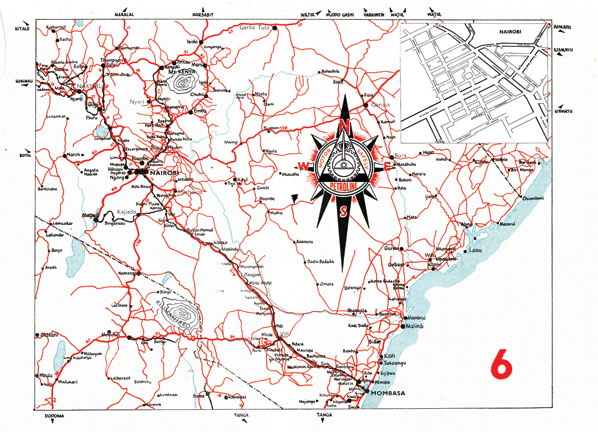 Cecil doesn't have quite as many documents from Africa because Hazel, Zeke and Dr. Kafour were a little too preoccupied to gather any, but they did save this map they acquired in Mombasa. The blue splotch north and west of Nairobi is Lake Naivasha, where Onkwani first lands the boat plane. The Mountain of the Black Wind is, of course, not shown on the map, but it is located a little north and east of Lake Naivasha, in the empty space near where the capital "N" in "Nyeri" is.
Cecil doesn't have quite as many documents from Africa because Hazel, Zeke and Dr. Kafour were a little too preoccupied to gather any, but they did save this map they acquired in Mombasa. The blue splotch north and west of Nairobi is Lake Naivasha, where Onkwani first lands the boat plane. The Mountain of the Black Wind is, of course, not shown on the map, but it is located a little north and east of Lake Naivasha, in the empty space near where the capital "N" in "Nyeri" is.
This large-format map is based on a real vintage driving map of Kenya published by a British petroleum company in the 1950s. We changed the name and logo of the company.
 While in Mombasa, Hazel bought some postcards to send back home to her parents. She wrote this one but never had a chance to put it in the mail.
While in Mombasa, Hazel bought some postcards to send back home to her parents. She wrote this one but never had a chance to put it in the mail.

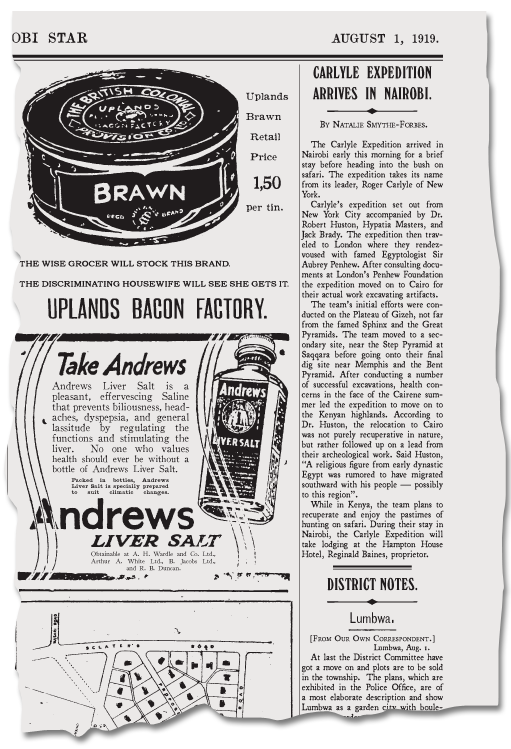 The Nairobi Star is another fictional newspaper, and our design is based on The East African Standard, a real English colonial newspaper published in Nairobi in the 1920s. The news items and classified ads on the reverse of all Nairobi Star clippings are real ones lifted from the Standard. Our thanks again to HPLHS Member David G. Cercone II for doing research at the Library of Congress.
The Nairobi Star is another fictional newspaper, and our design is based on The East African Standard, a real English colonial newspaper published in Nairobi in the 1920s. The news items and classified ads on the reverse of all Nairobi Star clippings are real ones lifted from the Standard. Our thanks again to HPLHS Member David G. Cercone II for doing research at the Library of Congress.
PLEASE NOTE: Your clipping may or may not be exactly the same size/shape as shown here. All the various newspaper clippings for this collection were designed and printed up in a giant full-size 12-page broadsheet newspaper. In order to get twice as many front pages, half of the newspaper is designed upside down. Our hard-working clipping shoggoths then meticulously disassemble these insanely complicated newspapers into the numerous different items, and there is always some variation in how specific individual clippings appear.
 This bonus clipping mentions Neville Jermyn. The son of Arthur Jermyn, from the HPL story "Some Facts Concerning the Late Arthur Jermyn and his Family", Neville is completely obsessed with the mythical city of the White Gorilla which he believes one of his ancestors found in the Congo. Sir Aubrey told Jermyn he was interested in going there in order to get his help in outfitting their Kenyan safari. Jermyn also corresponded with Madam Lin Yenyu in Shanghai on the subject of white gorillas.
This bonus clipping mentions Neville Jermyn. The son of Arthur Jermyn, from the HPL story "Some Facts Concerning the Late Arthur Jermyn and his Family", Neville is completely obsessed with the mythical city of the White Gorilla which he believes one of his ancestors found in the Congo. Sir Aubrey told Jermyn he was interested in going there in order to get his help in outfitting their Kenyan safari. Jermyn also corresponded with Madam Lin Yenyu in Shanghai on the subject of white gorillas.
The most famous white gorilla in real life was probably Snowflake, an albino Western lowland gorilla who was captured in 1966 and lived almost 40 years in the Barcelona zoo.
 This half-page clipping from The Nairobi Star gives an opportunity for a photo of the site where the Carlyle Expedition remains were found, and shows Mt. Satima rising into the clouds in the distance.
This half-page clipping from The Nairobi Star gives an opportunity for a photo of the site where the Carlyle Expedition remains were found, and shows Mt. Satima rising into the clouds in the distance.
The photo itself is a composite of several locations, including a burned field in Laos and a mountain in India.
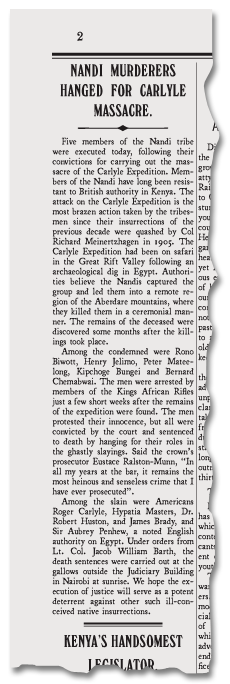 This final clipping from The Nairobi Star gives some more detail on the Nandi tribesmen who took the fall for the "massacre". All of the ads on the reverse side are real except the one for Ahja Singh.
This final clipping from The Nairobi Star gives some more detail on the Nandi tribesmen who took the fall for the "massacre". All of the ads on the reverse side are real except the one for Ahja Singh.
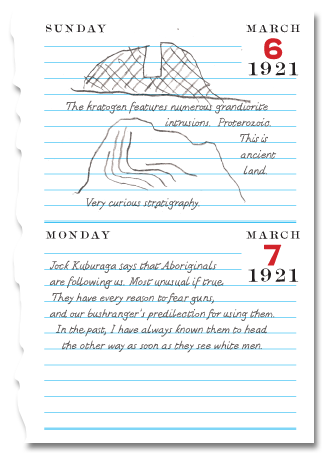 This is the diary that Professor Cowles showed to Hazel at Miskatonic, but after their experiences in Australia, Cecil went through Robert Mackenzie to get these pages. MacWhirr notes that the land of Western Australia is among the very oldest on the surface of the earth, and features the earliest evidence of life on the planet in the 3.5 billion-year-old rocks of the Pilbara.
This is the diary that Professor Cowles showed to Hazel at Miskatonic, but after their experiences in Australia, Cecil went through Robert Mackenzie to get these pages. MacWhirr notes that the land of Western Australia is among the very oldest on the surface of the earth, and features the earliest evidence of life on the planet in the 3.5 billion-year-old rocks of the Pilbara.
 Poor Professor Cowles has no idea what's coming when he sends this message. The prop is a replica of a real Australian telegram from the mid 1920s.
Poor Professor Cowles has no idea what's coming when he sends this message. The prop is a replica of a real Australian telegram from the mid 1920s.
 To draw this impromptu map of the City of the Great Race as they went along, Victoria used the biggest piece of paper she happened to have in her handbag, which was the back of a birding newsletter she had been carrying since England. (The number of exotic birds being murdered for the sake of women's hats in Victoria's lifetime was appalling, and she was an early member of the Plumage League.) At Cecil's request, she went in after the fact and tried to add labels to the map.
To draw this impromptu map of the City of the Great Race as they went along, Victoria used the biggest piece of paper she happened to have in her handbag, which was the back of a birding newsletter she had been carrying since England. (The number of exotic birds being murdered for the sake of women's hats in Victoria's lifetime was appalling, and she was an early member of the Plumage League.) At Cecil's request, she went in after the fact and tried to add labels to the map.
 This item is not specifically referenced in the show, but Cecil found this mimeographed memo on the floor of one of the passages in Pnakotus. Mimeography is a printing process that was popularized in the late 1800s that uses stencils to force ink from a rotating drum onto paper. The stencils were usually prepared on a typewriter with the ribbon removed. People sometimes used inventive combinations of typewritten letters, numbers, and punctuation marks to create little illustrations, kind of like the original emoticons. The one shown on this memo is the symbol of the Sand Bat as rendered on a typewriter. Shula had a version of this same symbol tattooed on her arm.
This item is not specifically referenced in the show, but Cecil found this mimeographed memo on the floor of one of the passages in Pnakotus. Mimeography is a printing process that was popularized in the late 1800s that uses stencils to force ink from a rotating drum onto paper. The stencils were usually prepared on a typewriter with the ribbon removed. People sometimes used inventive combinations of typewritten letters, numbers, and punctuation marks to create little illustrations, kind of like the original emoticons. The one shown on this memo is the symbol of the Sand Bat as rendered on a typewriter. Shula had a version of this same symbol tattooed on her arm.
 This item is also not referenced in the show, but Cecil grabbed it from Huston's desk in the panic before fleeing from his lair into the City of the Great Race. Huston got his mail delivered via Mortimer Wycroft.
This item is also not referenced in the show, but Cecil grabbed it from Huston's desk in the panic before fleeing from his lair into the City of the Great Race. Huston got his mail delivered via Mortimer Wycroft.
 This is one chapter of Huston's work in progress, Gods of Reality. Victoria took it from Huston's lair as they fled Pnakotus.
This is one chapter of Huston's work in progress, Gods of Reality. Victoria took it from Huston's lair as they fled Pnakotus.

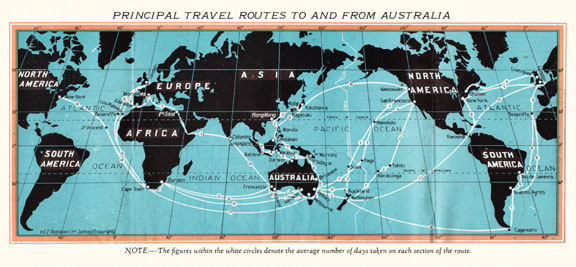 This map comes from a travel brochure that Niely Vanderbilt's trusty purser Willis picked up in Darwin.
This map comes from a travel brochure that Niely Vanderbilt's trusty purser Willis picked up in Darwin.
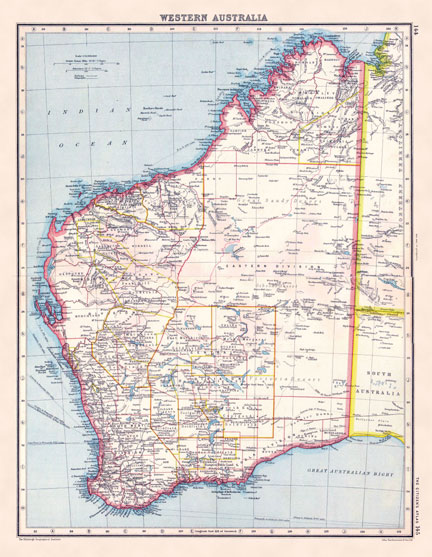 This map is one that Mark and Penny O'Brien picked up along with the other gear before setting out into the Great Sandy. Mark has indicated the location of the ruins supplied by MacWhirr's diary.
This map is one that Mark and Penny O'Brien picked up along with the other gear before setting out into the Great Sandy. Mark has indicated the location of the ruins supplied by MacWhirr's diary.
This large-format map is an edited replica of a real map from 1923. We added the Canning Stock Route and a couple of specific story locations to it.
 The Shanghai Courier is a fictional newspaper, but the design is inspired by The Shanghai Evening Post and Mercury, a real newspaper published in the early 1940s. Ads and news items on the backs of clippings are lifted from The Shanghai Mercury from the 1920s. Our thanks again to HPLHS Member David G. Cercone II for doing research at the Library of Congress.
The Shanghai Courier is a fictional newspaper, but the design is inspired by The Shanghai Evening Post and Mercury, a real newspaper published in the early 1940s. Ads and news items on the backs of clippings are lifted from The Shanghai Mercury from the 1920s. Our thanks again to HPLHS Member David G. Cercone II for doing research at the Library of Congress.
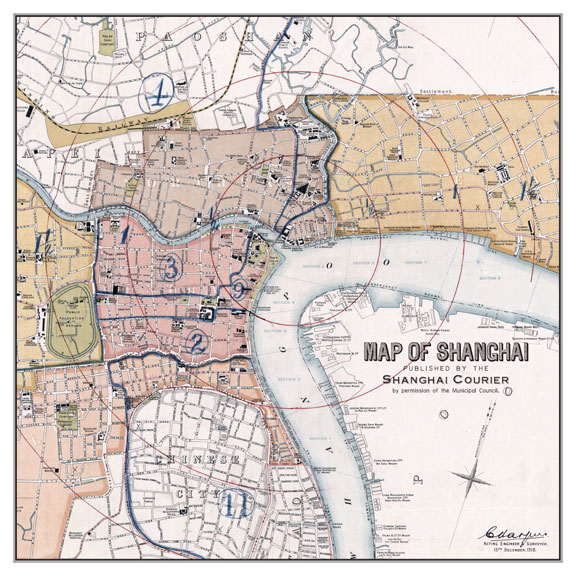 This was Jack Brady's personal map of the city, with a number of unlabeled Xs and a circle indicating places of particular interest.
This was Jack Brady's personal map of the city, with a number of unlabeled Xs and a circle indicating places of particular interest.
This large-format map is a detail of a fantastic map of Shanghai from 1919 we found in the Library of Congress, to which we added Lantern Street.

 When Jackson Elias first met Jack Brady in Shanghai, he gave him this calling card with the name of the guest house where he was staying in town. When Brady wanted to send a message to Zeke and Hazel, he scratched out that address and wrote a new note on the back.
When Jackson Elias first met Jack Brady in Shanghai, he gave him this calling card with the name of the guest house where he was staying in town. When Brady wanted to send a message to Zeke and Hazel, he scratched out that address and wrote a new note on the back.
Elias had no permanent address, so he used The Adventurers' Club as a base of operations in New York City. When there wasn't a room available at the club house, he liked to stay at the Hotel Chelsea....

 This page of notes was written my Mu Hsien on a piece of paper from his grandchildren's writing practice book.
This page of notes was written my Mu Hsien on a piece of paper from his grandchildren's writing practice book.
Very little is actually known about the Seven Cryptical Books of Hsan. Hsan is believed by some to have been a Tibetan monk living in the second century BCE, but no one is really sure. Lovecraft mentions the books in his tales "The Other Gods" and The Dream-Quest of Unknown Kadath. In both stories, the books are mentioned in conjunction with the Pnakotic Manuscripts. They are kept in the temple of the Elder Ones in the city of Ulthar. Madam Lin's copy is a very rare and precious thing indeed, possibly smuggled out of the Dreamlands through some occult means.
 Marine insurance is one of the oldest kinds of insurance, and this is a replica of a real Lloyd's of London insurance policy from the time period. Cecil acquired this copy of Vanderbilt's policy via professional courtesy from a colleague in London.
Marine insurance is one of the oldest kinds of insurance, and this is a replica of a real Lloyd's of London insurance policy from the time period. Cecil acquired this copy of Vanderbilt's policy via professional courtesy from a colleague in London.
Our thanks to HPLHS co-founder and maritime expert Darrell Tutchton for his input on marine insurance!
 Cecil clipped this article right before the survivors fled Shanghai. Neily Vanderbilt really did own a magnificent yacht called the North Star, named after the yacht owned originally by his great grandfather, railroad tycoon Cornelius Vanderbilt. (The Vanderbilt family did not have a lot of originality in the names department). There are photos of an amazing model of the ship at this link. In real life, Vanderbilt did not deliberately crash the ship. It was used by the British in the Great War, and Vanderbilt really did buy Astor's former yacht the Winchester, which was badly damaged when one of its fuel tanks exploded in the East River off Manhattan in 1930. Vanderbilt retired to a much smaller yacht, the Ambassadress, on which he died in 1942.
Cecil clipped this article right before the survivors fled Shanghai. Neily Vanderbilt really did own a magnificent yacht called the North Star, named after the yacht owned originally by his great grandfather, railroad tycoon Cornelius Vanderbilt. (The Vanderbilt family did not have a lot of originality in the names department). There are photos of an amazing model of the ship at this link. In real life, Vanderbilt did not deliberately crash the ship. It was used by the British in the Great War, and Vanderbilt really did buy Astor's former yacht the Winchester, which was badly damaged when one of its fuel tanks exploded in the East River off Manhattan in 1930. Vanderbilt retired to a much smaller yacht, the Ambassadress, on which he died in 1942.
Below are photos of the North Star and one of its staterooms. It was a very nice yacht.


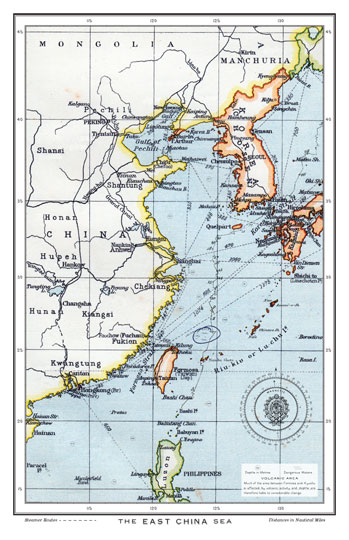 This large-format map is a nautical chart of the East China Sea that shows the general location of Gray Dragon Island. Niely's purser Willis acquired it in Shanghai and Cecil carried it with him on the island raid.
This large-format map is a nautical chart of the East China Sea that shows the general location of Gray Dragon Island. Niely's purser Willis acquired it in Shanghai and Cecil carried it with him on the island raid.
Real vintage nautical charts of the East China Sea are, it turns out, rather difficult to get. This prop is a doctored map from a vintage atlas.
 This curious item was one that Zeke and Jackson Elias encountered on their last case together, in which they investigated strange goings-on in Peru. This investigation is a part of Chaosium's game Masks of Nyarlathotep, and we won't spoil it by providing any more details here. Suffice it to say that Zeke should hope that no one at the Boys Club of Harlem looks into the mirror too closely....
This curious item was one that Zeke and Jackson Elias encountered on their last case together, in which they investigated strange goings-on in Peru. This investigation is a part of Chaosium's game Masks of Nyarlathotep, and we won't spoil it by providing any more details here. Suffice it to say that Zeke should hope that no one at the Boys Club of Harlem looks into the mirror too closely....
The prop was designed by Allan Carey and Seth Laster of Type40 in Australia, and inspired by artwork of Tiwanaku. It is die cast in a zinc alloy and plated with let's call it gold. It comes packaged in a bag imported from Peru which may or may not look exactly like the one shown here.
 These are the robes that Cecil and Victoria find in Zahra Shafik's private chambers. She and Gavigan and other high-ranking members of the Brotherhood of the Black Pharaoh wear them during cult ceremonies.
These are the robes that Cecil and Victoria find in Zahra Shafik's private chambers. She and Gavigan and other high-ranking members of the Brotherhood of the Black Pharaoh wear them during cult ceremonies.
Inspired by various religious garments, the bottom layer is an exorason, a lightweight black cassock or habit that is pulled over the head. The hood is optional, and it may be belted if necessary. Worn over the exorason is an outer vestment most similar to a phelonion. It is made of heavy black chenille with an inverted ankh made of red leather, and trimmed with tassels. The headpiece is inspired by the Deshret, the Red Crown of Lower Egypt. It is made of black felt and trimmed with another red leather inverted ankh.
The robes were designed by Laura Brody with some input from Andrew Leman. The phelonion and headpiece are both handmade by Laura Brody. The robes are packaged in a traditional style hat box handmade in New Hampshire.
(In an effort to make sure our robes fit most everyone, we have provided a voluminous one-size-fits-most cassock. If you find it's too big or too long, you can belt it with some simple black fabric if desired. Sometimes infiltrating a cult requires wearing a uniform that doesn't quite fit....)
Care Instructions: The exorason can be machine washed in warm water and line dried (don't put it in a dryer). The phelonion and headpiece should be professionally dry cleaned if needed.
 These are Edward Gavigan's personal scepters, which he carries during ceremonies of the Brotherhood of the Black Pharaoh. He has often used the crook to perform ritual sacrifices. The other scepter is topped with an inverted ankh. Both are made of an unidentifiable metal. When held crossed in front of the body, they increase magical power and provide magical protection. Zahra Shafik owns a similar pair.
These are Edward Gavigan's personal scepters, which he carries during ceremonies of the Brotherhood of the Black Pharaoh. He has often used the crook to perform ritual sacrifices. The other scepter is topped with an inverted ankh. Both are made of an unidentifiable metal. When held crossed in front of the body, they increase magical power and provide magical protection. Zahra Shafik owns a similar pair.
The props were designed by Allan Carey and Seth Laster of Type40 in Australia. They are cast from solid statuary bronze. There is some video of the design and forging process in the carousel of images at the top of this page. The scepters are packed in a fabric lined wooden box that is engraved with an image of the Was-scepter, an ancient Egyptian symbol of divine power and dominion, and an inverted ankh. The hieroglyphs in the cartouche spell out Gavigan's name.
The glass balls at the tips of the ankh are attached with epoxy. If they should become dislodged during transport or subsequent ritual use, we recommend using epoxy to reattach them.
 This item is not specifically referenced in the show because it comes from a portion of the Chaosium game that was left out of the dramatization. We won't spoil the game by providing any details here. Perhaps it will suffice to say that Omar al-Shakti is devoted to cats, and an amulet like this one might help him retain the good favor of his feline familiar, Hetep.
This item is not specifically referenced in the show because it comes from a portion of the Chaosium game that was left out of the dramatization. We won't spoil the game by providing any details here. Perhaps it will suffice to say that Omar al-Shakti is devoted to cats, and an amulet like this one might help him retain the good favor of his feline familiar, Hetep.
The prop was sculpted by Jason Hendricks. It is cast out of hydrostone.
 This is the enchanted fly whisk that Old Bundari gives to Dr. Kafour. It has the power to drive away evil spirits, and Dr. Kafour finds it works pretty well on Bloody Tongue cultists too.
This is the enchanted fly whisk that Old Bundari gives to Dr. Kafour. It has the power to drive away evil spirits, and Dr. Kafour finds it works pretty well on Bloody Tongue cultists too.
Fly whisks are more than simply useful tools to combat bothersome insects. In many African cultures they are symbols of power and authority, and are often included in traditional royal regalia. Fly whisks are also symbols of power in some Asian cultures. In Buddhism it symbolizes the banishment of ignorance and mental afflictions.
The prop was designed by Andrew Leman. The handle is made from the horn of a Springbok, a type of African antelope. The business end is made of horsehair, African porcupine hair, rooster tail feathers and goose quills. It comes packaged in a handmade cloth bag that may or may not look exactly like the one shown here.
 This is the small statue of the Bloated Woman form of Nyarlathotep that Madam Lin Yenyu has in her collection. It is made of mutton fat jade, and Madam Lin acquired it from Ho Fang, quite possibly under nefarious circumstances. It is kept in a puzzle box made of walnut and cherry wood that serves as a shrine.
This is the small statue of the Bloated Woman form of Nyarlathotep that Madam Lin Yenyu has in her collection. It is made of mutton fat jade, and Madam Lin acquired it from Ho Fang, quite possibly under nefarious circumstances. It is kept in a puzzle box made of walnut and cherry wood that serves as a shrine.
The prop was sculpted by Jason Hendricks. It is cast in polyurethane resin, with strands of wood excelsior embedded to simulate natural veining. If you notice any imperfections in the surface, please bear in mind that it has been used as a murder weapon on several occasions. The puzzle cabinet is made here at HPLHS using a laser cutter.
Below are some of Jason's original concept sketches and a photo of the statue in progress.


 These are the two halves of the Eye of Light and Darkness that Roger Carlyle broke off of the Red Pyramid. The left half was recovered by Jack Brady, who brought it to Mu Hsien in China. The right half was saved by Nuri of El Wasta, and given to Zeke and Dr. Kafour.
These are the two halves of the Eye of Light and Darkness that Roger Carlyle broke off of the Red Pyramid. The left half was recovered by Jack Brady, who brought it to Mu Hsien in China. The right half was saved by Nuri of El Wasta, and given to Zeke and Dr. Kafour.
The prop was designed by Sean Branney and Andrew Leman. It is cast from hydrostone.
